-

2022-05-29
This biography was created out of a self-directed project from the HST580 class. This biography will be linked to the submissions of the person mentioned in the document and title.
-

2022-06-04
This is a news story from The Seattle Times by Scott Greenstone. Pride has changed quite a bit over the last two years due to COVID. For a while, Pride celebrations were held virtually. The in-person events in 2022 will now resemble what Pride was like prior to the virus. Included in this article are personal stories of people who did not come out until the pandemic, with this year being the first year they will attend Pride in-person.
For some, they didn't realize they were trans until the pandemic hit. Rhys Hutton, for instance, did not know he was trans, and is also coming to grips with having autism. Hutton's story of how he came to the realization started on TikTok when the algorithm kept showing videos of trans-masculine people. This exposure helped him figure out his identity more.
Stories like this are not uncommon, according to a recent Gallup poll, ten percent of Millennials and twenty percent of Gen Z identify as LGBTQ+.
-

2022-06-08
This is a news story from CNN by Jamie Gumbrecht. Moderna believes that their COVID-19 booster is effective against Ominicron, and more effective compared to the normal two doses. The claim is that the booster provided a stronger antibody response than the initial two doses.
-

2022-06-09
This is a news story from CNN by Donald Judd and Betsy Klein. The Biden administration has announced a vaccine rollout for children five and under. The vaccinations are to start as early as the week of June 20.
-

2022-06-06
This biography was created out of a self-directed project from the HST580 class. This biography will be linked to the submissions of the person mentioned in the document and title.
-

2022-06-06
This biography was created out of a self-directed project from the HST580 class. This biography will be linked to the submissions of the person mentioned in the document and title.
-
2022-06-01
I remember the days leading up to lock down, one of my professors was warning us that if need be we would effortlessly be able to transition the remaining weeks of class online. To my peers and I, we thought that was a little extreme to talk to us about going remote, we didn't think something that was happening in another continent would reach us so quickly. Fast forward a week or two, work was so slow we were ordering food and sitting around talking for the entirety of our shift. At the time I was a host and was getting paid hourly so I didn't mind but I didn't think about the way it was affecting our bartenders and servers. Within the next two days we were shutdown and I was filing for unemployment. Interestingly enough, that time was the most money I've ever made in my life. I was collecting 2-3x more money than I would have gotten if I was working. I changed my life style, I started nannying once August of 2022 came around because I couldn't afford to only have my hourly host pay once things started to open back up again. I was eventually given a promotion at work to Bartend once my nanny family no longer needed me since they were comfortable with the kids going back to school and day care. I was making a livable wage but it was nothing compared to what sales were before covid. It was never consistent, when the numbers began to spike people, reasonably so, would stay home and money was tight. I was so unhappy at my current job I was despiertly seeking a new one but in January of 2022, it was still a little scary, numbers were spiking and finding a new industry job seemed next to impossible. I found one but it came with a lot of consequences. I struggled financially for months. If it wasn't for the support of my family, I wasn't sure if I would have been able to make rent, pay my car, or even feed myself. Thankfully as the months have gone on it's gotten better. It's now June of 2022; over two years since the pandemic first started, and while nothing is normal, it's the closest it's ever been. Those who were once in the same position as me, scared of how they were going to survive are back to making livable wages. But I won't lie, I'm still scared, there is no certainty or promise that things will stay as "normal" as they are this 2022 summer. All we can do is hope and pray, and be thankful and grateful we're here to talk about it.
-
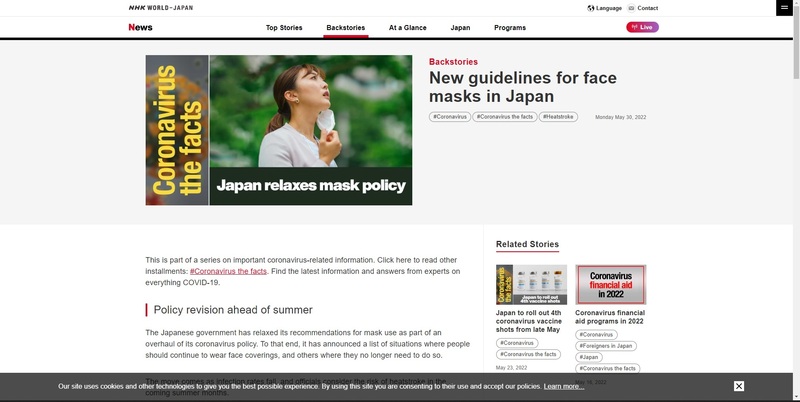
2022-05-30
Japan, as of May 30th, 2022, is relaxing the face mask guidelines. For the most part, masks do not need to be worn outdoors except when the elderly are in close quarters to other people. Indoors, masks are still required indoors except in the case of when someone is in little to no conversation, which the article shows in a chart. The chart's example states walking around museums and libraries where there is little to no conversation. One of the reasons for why Japan is relaxing face masks is because summer is approaching and the temperature will rise. There are fears about face masks causing heatstroke. In Japan, temperatures can range from 70-90 degrees F, but the summers are hot and humid too. So, it makes sense to relax the restrictions, especially in the outdoors.
-

2022-05-26
This biography was created out of a self-directed project from the HST580 class. This biography will be linked to the submissions of the person mentioned in the document and title.
-

2020-09-20
This assignment was given to students in Northeastern University's HIST 1219, History of Global Pandemics, taught by Dr. Streets-Salter in Fall 2020, and then taught by a graduate student in Fall 2021.
-
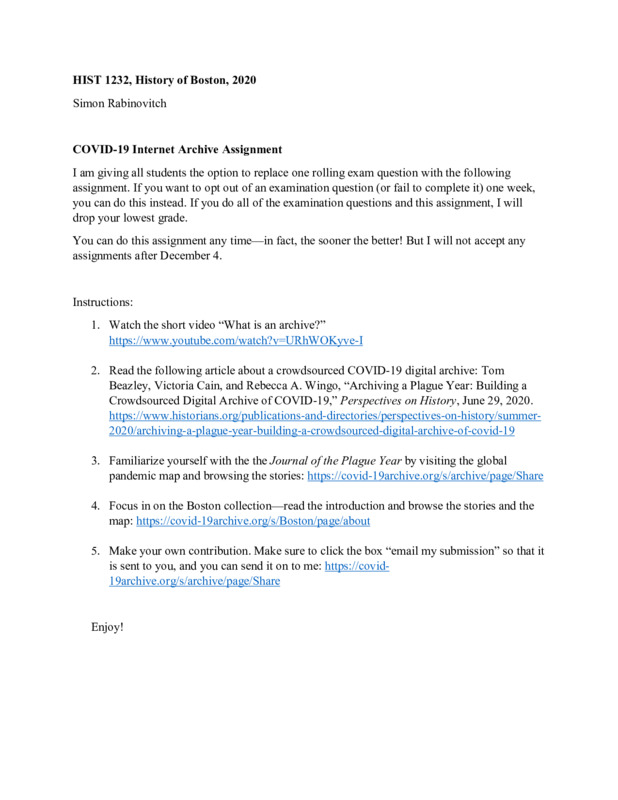
2020-12-04
This is an optional assignment given to students in Northeastern University HIST 1323, History of Boston, taught by Dr. Rabinovitch in Fall 2020.
-
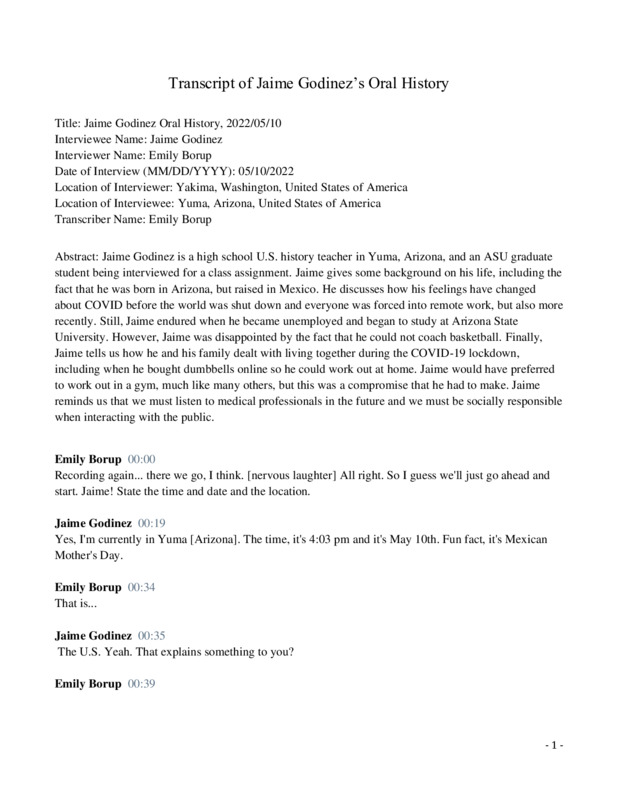
2022-05-10
Jaime Godinez is a high school U.S. history teacher in Yuma, Arizona, and an ASU graduate student being interviewed for a class assignment. Jaime gives some background on his life, including the fact that he was born in Arizona, but raised in Mexico. He discusses how his feelings have changed about COVID before the world was shut down and everyone was forced into remote work, but also more recently. Still, Jaime endured when he became unemployed and began to study at Arizona State University. However, Jaime was disappointed by the fact that he could not coach basketball. Finally, Jaime tells us how he and his family dealt with living together during the COVID-19 lockdown, including when he bought dumbbells online so he could work out at home. Jaime would have preferred to work out in a gym, much like many others, but this was a compromise that he had to make. Jaime reminds us that we must listen to medical professionals in the future and we must be socially responsible when interacting with the public.
-
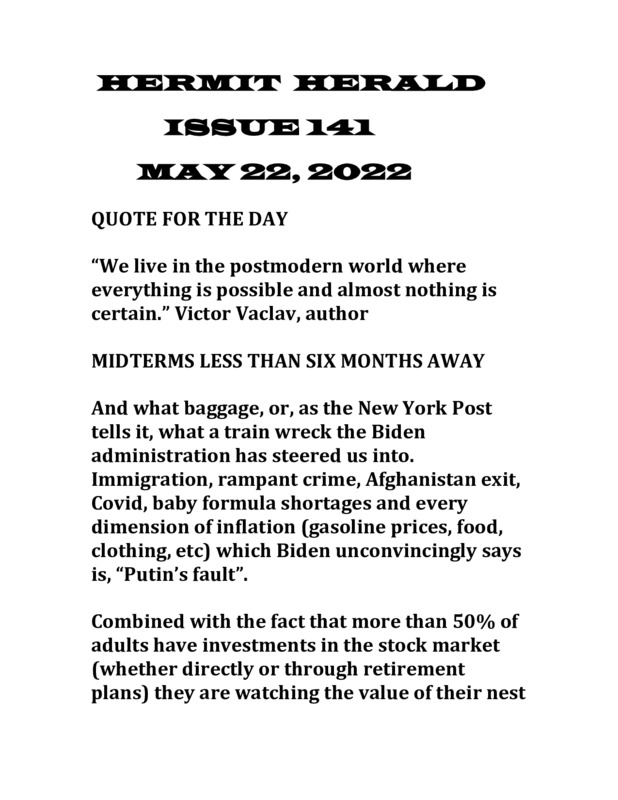
2022-05-22
Republican blowout at midterms? not so fast
-

2022-05-24
This biography was created out of a self-directed project from the HST580 class. This biography will be linked to the submissions of the person mentioned in the document and title.
-
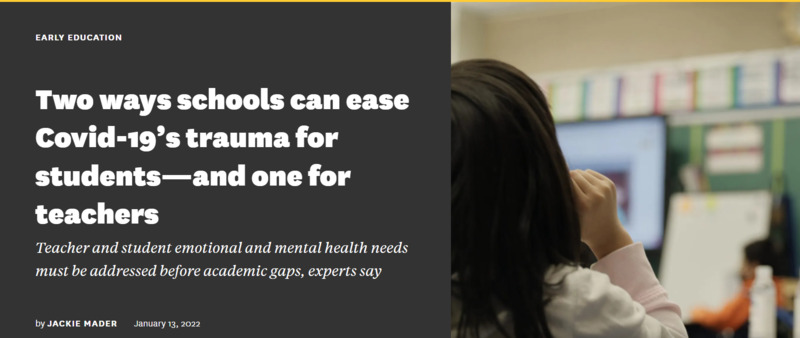
2022-01-13
COVID-19 has had a huge impact on both students and teachers. Not only has there been learning gaps, but there has also been an impact on the social and emotional well-being of teachers and students.
Many experts now say that these issues need to be addressed before focusing more on academics.
-

2022-02-01
According to a poll given by the National Education Association, 55% of teachers who participated feel burned out enough from COVID-19 to quit. Some of the reasons that COVID-19 has caused additional stress for teachers is due to student behavior, additional responsibilities, and longer hours.
-
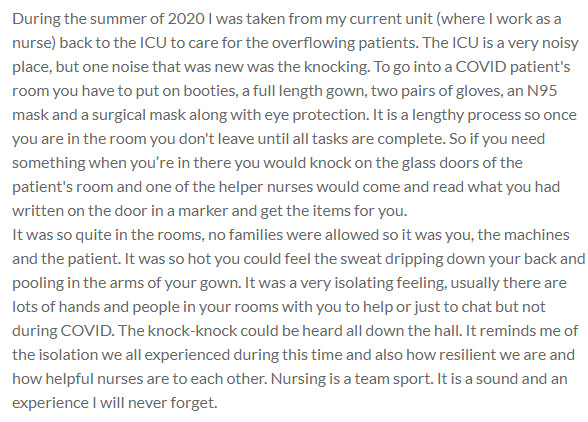
2020-08-06
During the summer of 2020 I was taken from my current unit (where I work as a nurse) back to the ICU to care for the overflowing patients. The ICU is a very noisy place, but one noise that was new was the knocking. To go into a COVID patient's room you have to put on booties, a full length gown, two pairs of gloves, an N95 mask and a surgical mask along with eye protection. It is a lengthy process so once you are in the room you don't leave until all tasks are complete. So if you need something when you’re in there you would knock on the glass doors of the patient's room and one of the helper nurses would come and read what you had written on the door in a marker and get the items for you.
It was so quite in the rooms, no families were allowed so it was you, the machines and the patient. It was so hot you could feel the sweat dripping down your back and pooling in the arms of your gown. It was a very isolating feeling, usually there are lots of hands and people in your rooms with you to help or just to chat but not during COVID. The knock-knock could be heard all down the hall. It reminds me of the isolation we all experienced during this time and also how resilient we are and how helpful nurses are to each other. Nursing is a team sport. It is a sound and an experience I will never forget.
-

2022-05-24
This biography was created out of a self-directed project from the HST580 class. This biography will be linked to the submissions of the person mentioned in the document and title.
-

2022-05-28
This biography was created out of a self-directed project from the HST580 class. This biography will be linked to the submissions of the person mentioned in the document and title.
-
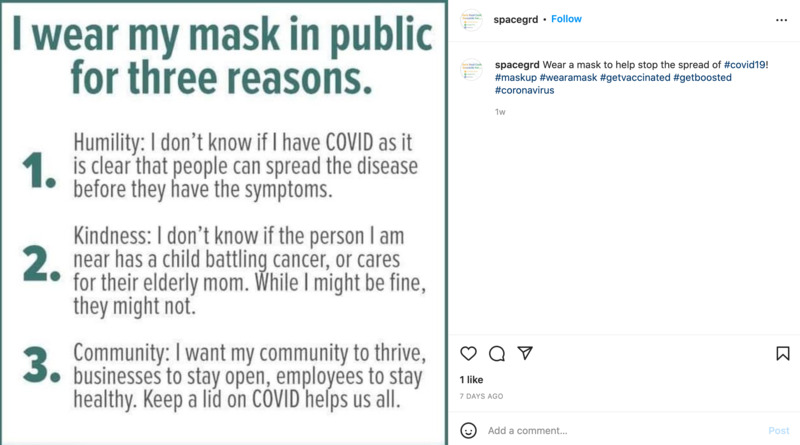
2022-05-21
This is an Instagram post by spacegrd. This is an infographic on why someone would choose to wear a mask. The three reasons are: humility, kindness, and community.
-
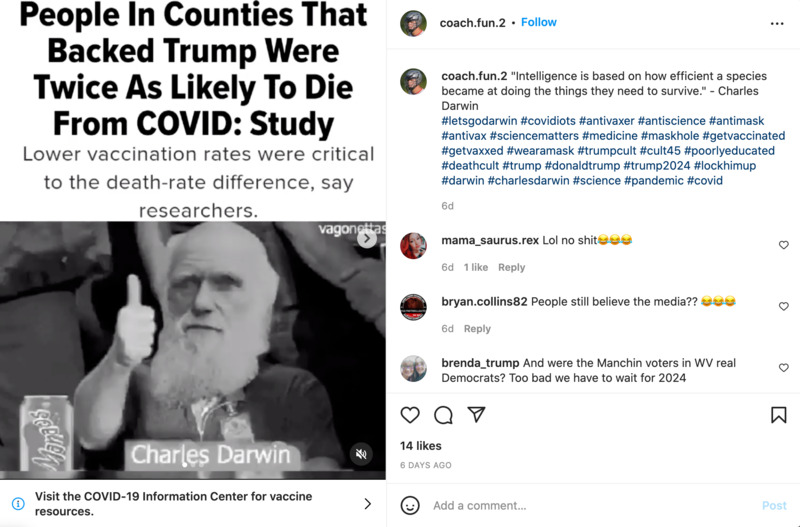
2022-05-22
This is an Instagram post by coach.fun.2. The study is not linked in the description, but I did find the article the title is referencing. The story come from the Huffington Post. It says that political affiliation is linked to vaccination rates, which some claim are what is making the difference between living and dying from COVID. Wealth and access to certain care are also taken into account. The study was from Brown and the study claims that states that went heavily for Trump had more cases of COVID deaths.
-
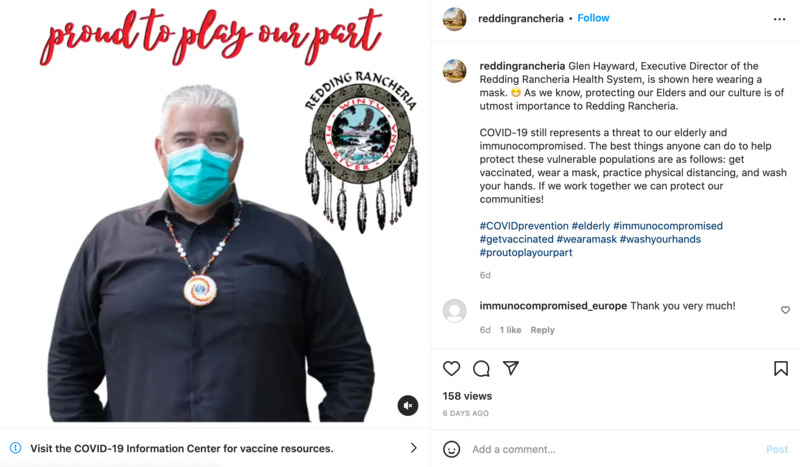
2022-05-22
This is an Instagram post by reddingrancheria. This is an advertisement for wearing a mask to protect the elderly. Seeing as elderly are more at risk for dying of COVID, I can understand why elderly would wear masks more often themselves, in addition to their caretakers wearing masks frequently.
-
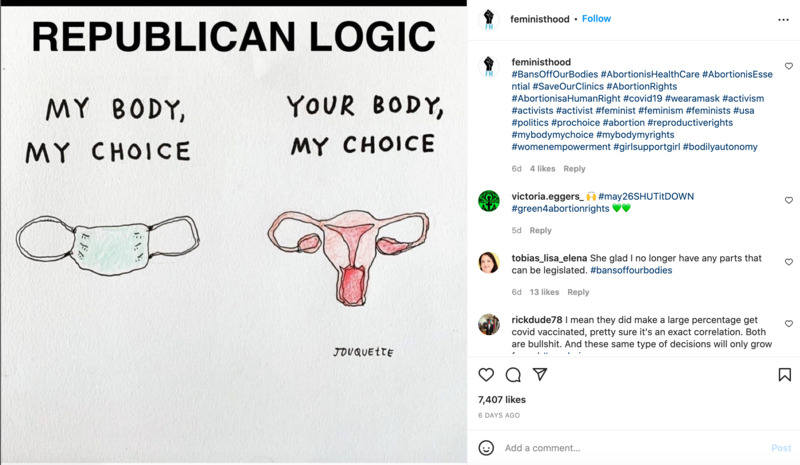
2022-05-22
This is an Instagram post from feministhood. It is making the comparison between the rhetoric Republicans have had regarding COVID versus abortion. The person writing this says thinks that it is rather contradictory. The contradiction comes from thinking that "my body, my choice" applies to masks and vaccines, but should not apply to abortion. The commonality is that both issues deal with bodily autonomy.
-
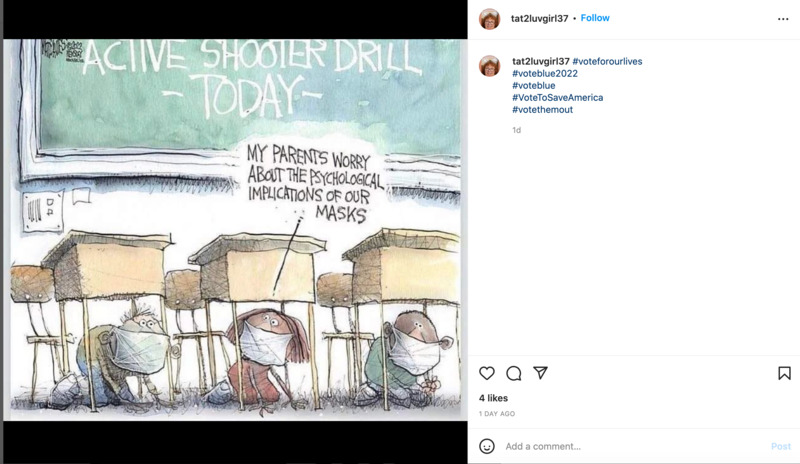
2022-05-28
This is an Instagram post by tat2luvgirl37. This is a political comic referencing both school shootings and mask wearing. The comic artist is trying to create irony where the parents of one of the kids seems to worry more about mask wearing rather than gun protection. The mask versus no-mask camp is highly partisan, with the no-maskers typically being Republican in the United States, and the pro-maskers being Democrat. Additionally, the Republican party is overall viewed as being more-pro gun, which some critics say is the reason why mass shootings happen more often. As we can see by the #voteblue used by the person that reposted this comic, it is very politically charged and meant to be criticism against those that are pro-gun and anti-mask.
-
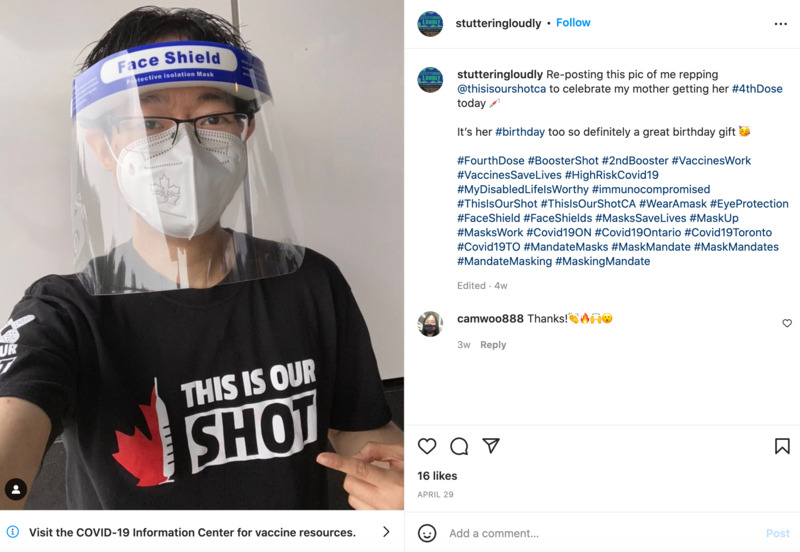
2022-04-29
This is an Instagram post by stutteringloudly. This person is celebrating his mom getting her fourth dose.
-
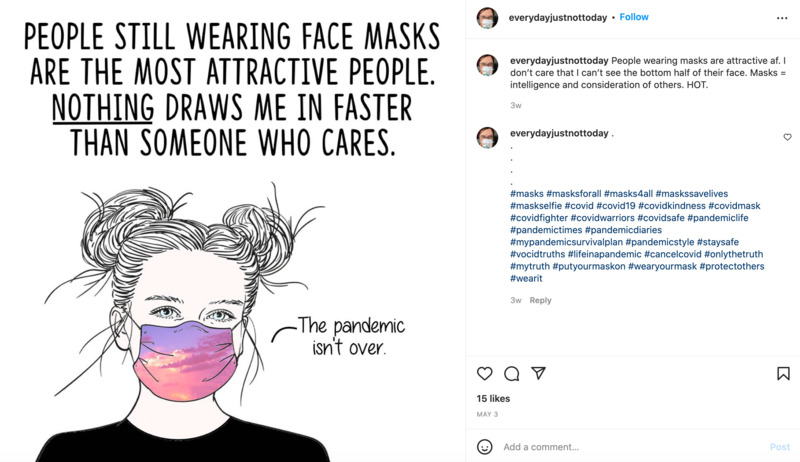
2022-05-03
This is an Instagram post by everydayjustnottoday. The person that posted this equates masks with intelligence. Intelligence to this person is attractive. Masks have been a controversial topic due to the belief that they will inhibit communication or cause psychological issues. There are many different sides to this debate.
-
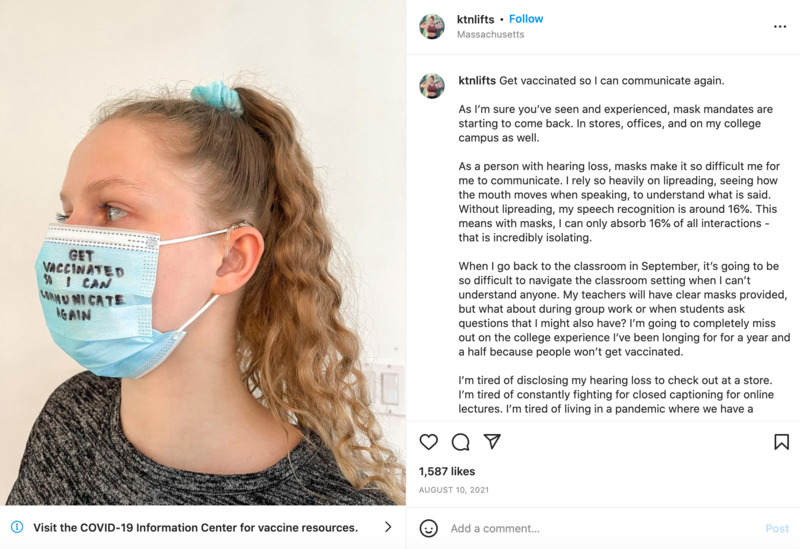
2021-08-10
Caption to post:
As I’m sure you’ve seen and experienced, mask mandates are starting to come back. In stores, offices, and on my college campus as well.
As a person with hearing loss, masks make it so difficult me for me to communicate. I rely so heavily on lipreading, seeing how the mouth moves when speaking, to understand what is said. Without lipreading, my speech recognition is around 16%. This means with masks, I can only absorb 16% of all interactions - that is incredibly isolating.
When I go back to the classroom in September, it’s going to be so difficult to navigate the classroom setting when I can’t understand anyone. My teachers will have clear masks provided, but what about during group work or when students ask questions that I might also have? I’m going to completely miss out on the college experience I’ve been longing for for a year and a half because people won’t get vaccinated.
I’m tired of disclosing my hearing loss to check out at a store. I’m tired of constantly fighting for closed captioning for online lectures. I’m tired of living in a pandemic where we have a solution to end it.
Vaccines work. Vaccines save lives. Getting the vaccine means you’re helping deaf and hard of hearing people get back to a place where they can communicate again.
SAVE this post and SHARE to spread awareness. This topic is NOT talked about enough and it’s something that affects the deaf and hard of hearing community every single day.
ID IN COMMENTS
-

2022-05-28
This is a news story from Reuters. After intense lockdowns, Shanghai is looking to reopen again.
Shanghai officials urged continued vigilance, even though the vast majority of its 25 million residents live in areas that are in the lowest-risk "prevention" category.
"Wear masks in public, no gathering and keep social distance," Zhao Dandan, deputy director of the Shanghai Municipal Health Commission, told a daily news conference.
Similar measures are being taken in Beijing, where things are reopening there too, but with restriction.
Starting on Sunday, shopping malls, libraries, museums, theatres and gyms will be allowed to reopen, with limits on numbers of people, in the eight of Beijing's 16 districts that have seen no community cases for seven consecutive days.
-
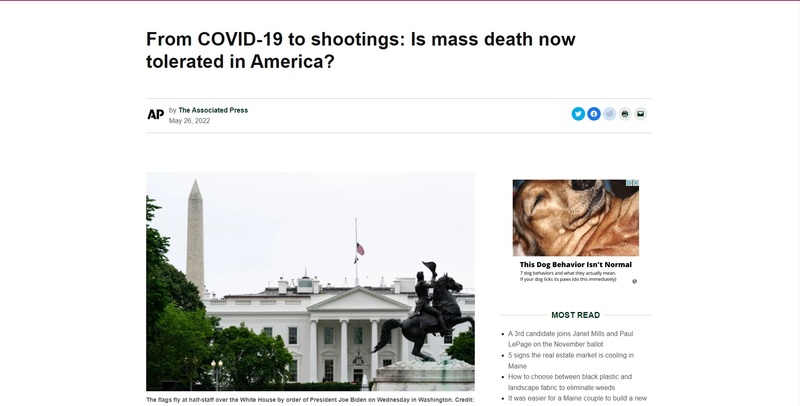
2022-05-26
This is a news story from The Associated Press. Just recently, there have been over one million COVID deaths recorded in the United States. The author of this piece asks if Americans have just begun to tolerate mass death. Racial and social inequalities are also cited, where the author claims that those of certain backgrounds are more likely to die sooner or more violently. The COVID deaths are then related to the recent shooting deaths, such as in Buffalo and in Texas. While the gun violence deaths are lower than the COVID deaths, the author uses this to show that little is being done for either to help lessen the amount of deaths.
I don't agree with the author completely on this due to dying from COVID being very different from dying from a mass shooter. With COVID, people could pass it along unknowingly and get someone infected, as it is an asymptomatic spread. With a mass shooter, it is much less predictable and far more sudden. From what I have seen on my social media, I did not see anyone I follow really mark the 1,000,000 COVID death milestone, but many have expressed outrage over both the Buffalo and Texas shootings. I don't think the question should be whether Americans accept mass death or not, but of methods of prevention. Obviously, gun ownership won't solve all problems. The police that had guns were waiting outside the school as the shooter was slaughtering kids and adults. Though, one man with a gun, a border patrol agent, is who finally shot the mass shooter and killed him. This is more of a question of character, as well as how competent police forces are in these scenarios. I do not think the author made a fair comparison because protecting yourself from COVID to prevent death would be an entirely different process than protecting yourself from a mass shooter. While the goal of preserving life is the same, the methods differ. Outrage isn't an issue because I have seen people upset over death from COVID and mass shootings. The main problem I see is that people have trouble coming together on a solution.
-
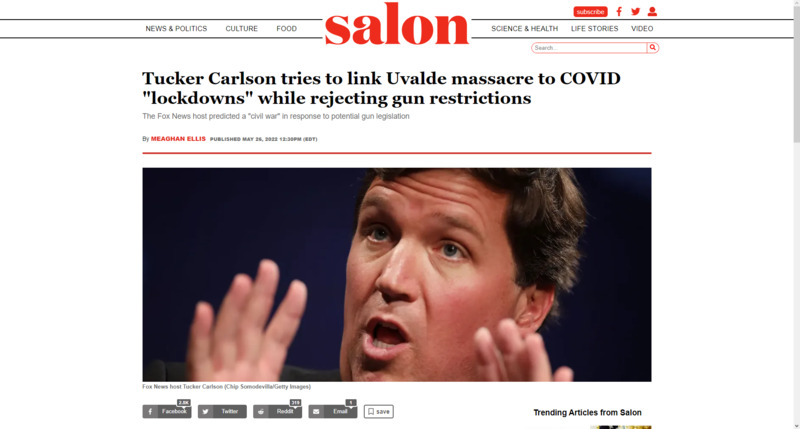
2022-05-26
This is a news story from Salon by Meaghan Ellis. This is an opinion piece on what this author thinks about Fox News contributor Tucker Carlson and his approach to the shooting in Texas. The news story says that Carlson claims the lockdowns increased mental illness cases.
Whether this is true remains to be seen, but from my own experience with lockdowns, I did have trouble adjusting. I had at least a few mental breakdowns over feeling like a prisoner in my own home. I don't think the lockdowns would trigger everyone into becoming a potential mass shooter, but I do not think they were healthy for many people either. People need human contact regularly, and being cut off from that and only having social media or very few people to see in-person would feel isolating. I think mental health is not paid attention to enough by public health officials when it comes to lockdowns. Mental health is still part of overall health. I do understand why the lockdowns happened, but I think many went on too long, which has had a bad effect on society. It is obviously not the only reason someone would have a mental illness, but for people that already did have mental issues, it made them worse. I have high functioning autism and without a good support system, I'd possibly be doing way worse.
-
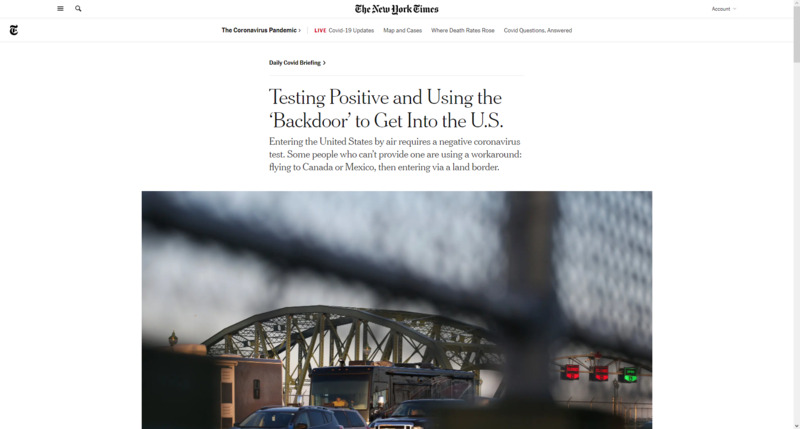
2022-05-28
This is a news story from the New York Times by Ceylan Yeginsu. This is about how people have been finding ways to bypass restrictions while traveling. Land crossings are a way some people are doing this, since land crossing does not require testing for entry into some countries. One way this could be done is doing the mandatory self-isolation period of five days, than choosing a different flight to a country like Mexico first, to then cross into the United States by land to avoid the ten day isolation required for testing positive for COVID. This article is quite interesting because it shows the ways in which COVID restrictions can be bypassed through loopholes within the framework. I have no idea the amount of people that actually do this, but at least a few have noticed ways to get out of restrictions.
-
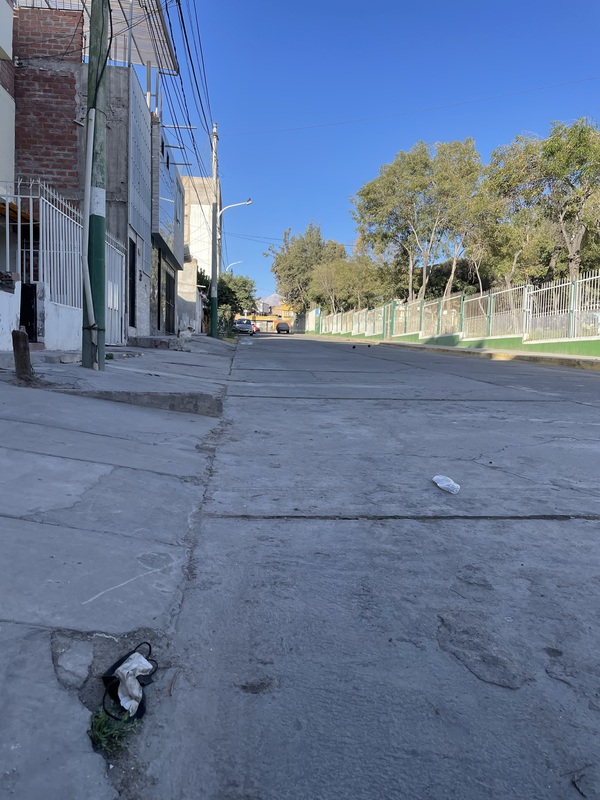
2022-05-27
Picture of a black disposable mask in the street near Parque 15 de Enero de la Independencia in Arequipa, Peru.
-
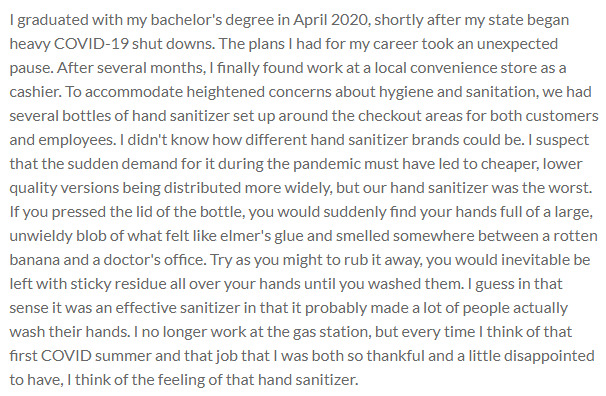
2020-07
I graduated with my bachelor's degree in April 2020, shortly after my state began heavy COVID-19 shut downs. The plans I had for my career took an unexpected pause. After several months, I finally found work at a local convenience store as a cashier. To accommodate heightened concerns about hygiene and sanitation, we had several bottles of hand sanitizer set up around the checkout areas for both customers and employees. I didn't know how different hand sanitizer brands could be. I suspect that the sudden demand for it during the pandemic must have led to cheaper, lower quality versions being distributed more widely, but our hand sanitizer was the worst. If you pressed the lid of the bottle, you would suddenly find your hands full of a large, unwieldy blob of what felt like elmer's glue and smelled somewhere between a rotten banana and a doctor's office. Try as you might to rub it away, you would inevitable be left with sticky residue all over your hands until you washed them. I guess in that sense it was an effective sanitizer in that it probably made a lot of people actually wash their hands. I no longer work at the gas station, but every time I think of that first COVID summer and that job that I was both so thankful and a little disappointed to have, I think of the feeling of that hand sanitizer.
-
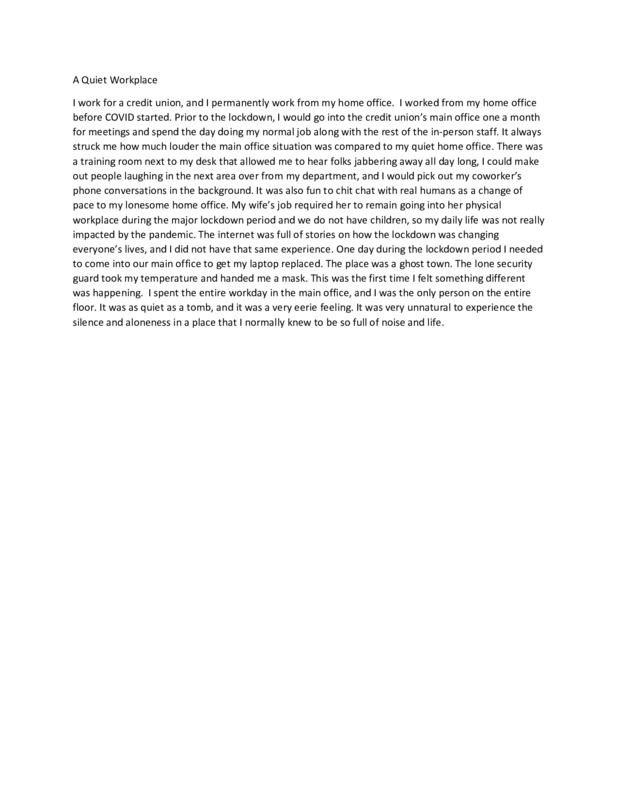
2022-05-27
This is to describe the sensory changes I experienced when I visited my employer's main office during the lockdown.
-
2020-05-17
The warmest April on record, yet we were all stuck inside. The streets usually congested with the honks of angry black cabbies, the loud hum of overused mufflers on double decker buses and the low rumble of the tube running underfoot were silent. The metropolis of over nine million people had come to a standstill. Windows usually closed to protect against the sleet or smog, were opened to quiet clean breezes. London felt serene, almost idyllic, until the piercing siren of an ambulance run would cut through that fairytale.
Before COVID I never paid attention to the St. John’s Ambulance First Aid Training facility on my street, only occasionally seeing the paramedics pop in the Arabic supermarket next door during lunch. As the news was counting the number of days we were in lockdown, I started counting the number of ambulances lining my street; popping my head out the open windows, looking up and down the road. However, sitting in my favorite chair in my flat, back to the window, I could avoid the grim sight, a constant reminder of the reality of the pandemic.
I would take my tea in that purple chair, alternating between endless Netflix shows and books, the church bells across the street the only thing to remind me of time. The warm sun and smog less breeze would join the bells drifting through the open windows. Through the books and shows, I not only escaped COVID but my small London flat. The silence of the city amplifying my imagination, only to be shattered by that first initial scream of the sirens, jolting me back to reality. Willing to sacrifice the warm breeze at my back, I closed my windows to protect my ears and the fantasies I had created. However, the double paned windows, sturdy enough to block out the honks of angry black cabbies, were no match for the sirens.
Unable to even slightly defend against the shock of the sirens when surrounded by the new silence of the city, I learned to live with it. I reopened my windows to let in bells, breezes, and sirens, instead tuning my ear to notice the ambulance’s first turn of the engine to brace for the piercing scream that would soon follow. As the days continued, my ears started to acclimate to this new normal, with each ambulance run making me jump a little less off my chair. Though my body and mind would never accept the sound enough to not to jolt me even from the deepest sleep, as if to remind me that this was anything but normal.
-
2020-09-01
One of the most profound sensory experiences I had over the course of the COVID-19 pandemic was the new yet comforting experiences that engaged all the senses of visiting St. Anthony the Great Monestary in Florence, Arizona. My first visit, I stayed for a long weekend. Visitors remaining at the monestary for more than a day are put to work on the grounds, aiding the monks in their daily work. I was put in the kitchen due to my previous experience in a commercial kitchen setting.
The diet at the monastery is remarkably simple; a bean and rice soup, bread, and tangerines grown at the monastery. None of the smells of these foods were new or remarkable to me, but instead this provided an interesting aural experience. The monks pray constantly in everything they do, and kitchen work was no different. Low, repetitive Greek prayers were the only auditory input in the kitchen, aside from the hum of the dishwasher and the clinking of utensils against pots.
Services were held in the early morning, around 3:00am. While making my way from the guests' lodging to the church, I heard a rhythmic wood-on-wood striking, reverberating across the monastery. I saw the source. A monk was striking a wooden board, suspended in the air by two chains, with two wooden mallets. This was essentially the call for the service to start. I later learned from another pilgrim that this practice was adopted by Greeks living in Ottoman-controlled Greece when restrictions on church bells were implemented.
The service itself, too, was a sensory experience unlike any other. Sonorous Byzantine chants, clouds of aromatic incense, all lit by candlelight and a handful of small oil lamps. The sense of touch was also engaged; I felt the wool prayer rope in my hand, each knot a tactile counter for the number of prayers completed. Nearly every sense was full engaged in this temporary and much needed respite from the chaos of the outside world during uncertain times.
-
2020-05-01
From 2005 to 2020, I was a police officer. My life was hectic and noisy. I carried two mandatory work cell phones everywhere I went, 24 hours a day, which rang, beeped, and chirped continuously. A police radio was on in my house, in my car, or in my ear, every hour of the day. In my world, people were always talking, at work and at home. I resigned from my position in April of 2020, just as the COVID lockdowns were coming into effect. I suddenly found myself with nowhere to be due to no longer having a job and having minimal to no contact with others due to the lockdown. Being an avid flyfisher, my days became about spending most of my time on the river alone. This was also not normal, as I am also a flyfishing guide, and am used to fishing with other people, who are usually talking to me, but due to COVID, I no longer had clients. The constant of my life went from hearing people talking (and yelling) and devises making noise, to the sound of the rushing water of the river. I soon found improvements appearing in my life. I began feeling better, sleeping better, eating better, was able to focus more, and had a much more positive attitude. All of which were side effects of being on the river everyday by myself. The COVID pandemic was an opportunity for people to re-connect with nature unknowingly, as outdoor activities were their only choice of recreation outside of their homes. Due to outdoor activity being the only option for recreation, people learned, or remembered in some cases, the value which nature can add to life, as well as how simple it is to take nature for granted. The pandemic forced people back into nature, which re-awakened (or maybe awakened for the first time) the special relationship between the human senses and nature.
-
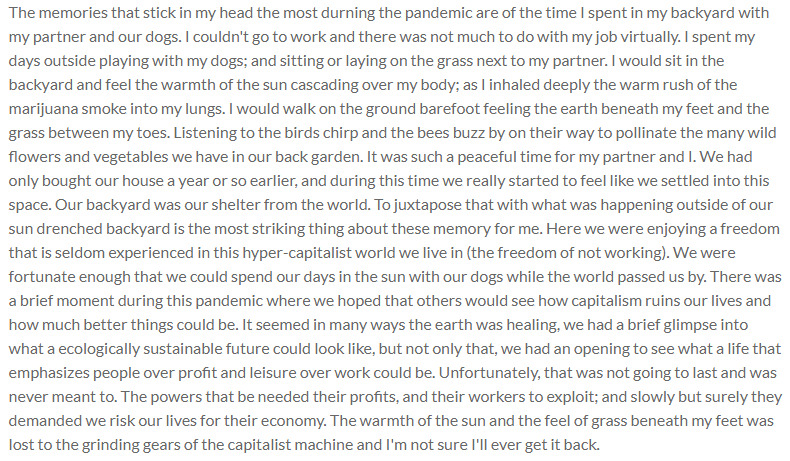
2020-04-10
The memories that stick in my head the most durning the pandemic are of the time I spent in my backyard with my partner and our dogs. I couldn't go to work and there was not much to do with my job virtually. I spent my days outside playing with my dogs; and sitting or laying on the grass next to my partner. I would sit in the backyard and feel the warmth of the sun cascading over my body; as I inhaled deeply the warm rush of the marijuana smoke into my lungs. I would walk on the ground barefoot feeling the earth beneath my feet and the grass between my toes. Listening to the birds chirp and the bees buzz by on their way to pollinate the many wild flowers and vegetables we have in our back garden. It was such a peaceful time for my partner and I. We had only bought our house a year or so earlier, and during this time we really started to feel like we settled into this space. Our backyard was our shelter from the world. To juxtapose that with what was happening outside of our sun drenched backyard is the most striking thing about these memory for me. Here we were enjoying a freedom that is seldom experienced in this hyper-capitalist world we live in (the freedom of not working). We were fortunate enough that we could spend our days in the sun with our dogs while the world passed us by. There was a brief moment during this pandemic where we hoped that others would see how capitalism ruins our lives and how much better things could be. It seemed in many ways the earth was healing, we had a brief glimpse into what a ecologically sustainable future could look like, but not only that, we had an opening to see what a life that emphasizes people over profit and leisure over work could be. Unfortunately, that was not going to last and was never meant to. The powers that be needed their profits, and their workers to exploit; and slowly but surely they demanded we risk our lives for their economy. The warmth of the sun and the feel of grass beneath my feet was lost to the grinding gears of the capitalist machine and I'm not sure I'll ever get it back.
-
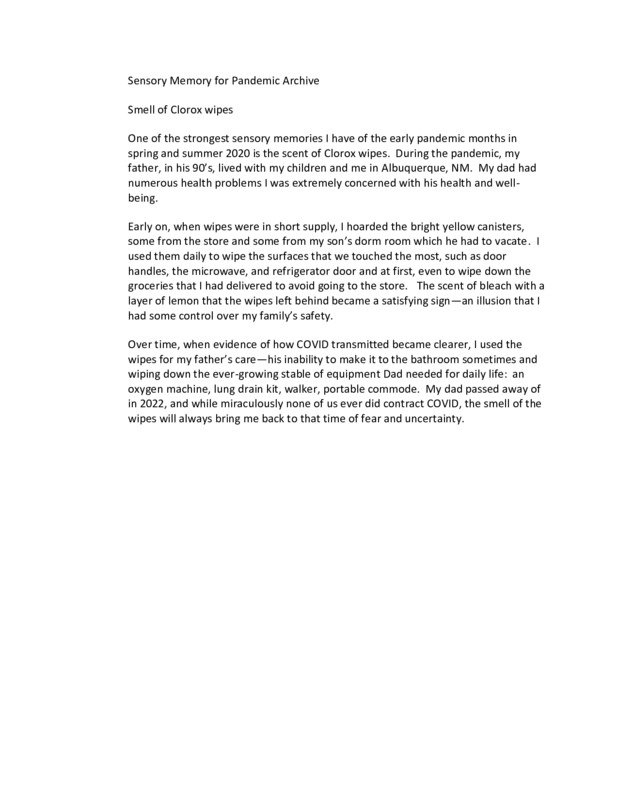
2022-05-27
Sensory Memory for Pandemic Archive
Smell of Clorox wipes
One of the strongest sensory memories I have of the early pandemic months in spring and summer 2020 is the scent of Clorox wipes. During the pandemic, my father, in his 90’s, lived with my children and me in Albuquerque, NM. My dad had numerous health problems I was extremely concerned with his health and well-being.
Early on, when wipes were in short supply, I hoarded the bright yellow canisters, some from the store and some from my son’s dorm room which he had to vacate. I used them daily to wipe the surfaces that we touched the most, such as door handles, the microwave, and refrigerator door and at first, even to wipe down the groceries that I had delivered to avoid going to the store. The scent of bleach with a layer of lemon that the wipes left behind became a satisfying sign—an illusion that I had some control over my family’s safety.
Over time, when evidence of how COVID transmitted became clearer, I used the wipes for my father’s care—his inability to make it to the bathroom sometimes and wiping down the ever-growing stable of equipment Dad needed for daily life: an oxygen machine, lung drain kit, walker, portable commode. My dad passed away of in 2022, and while miraculously none of us ever did contract COVID, the smell of the wipes will always bring me back to that time of fear and uncertainty.
-
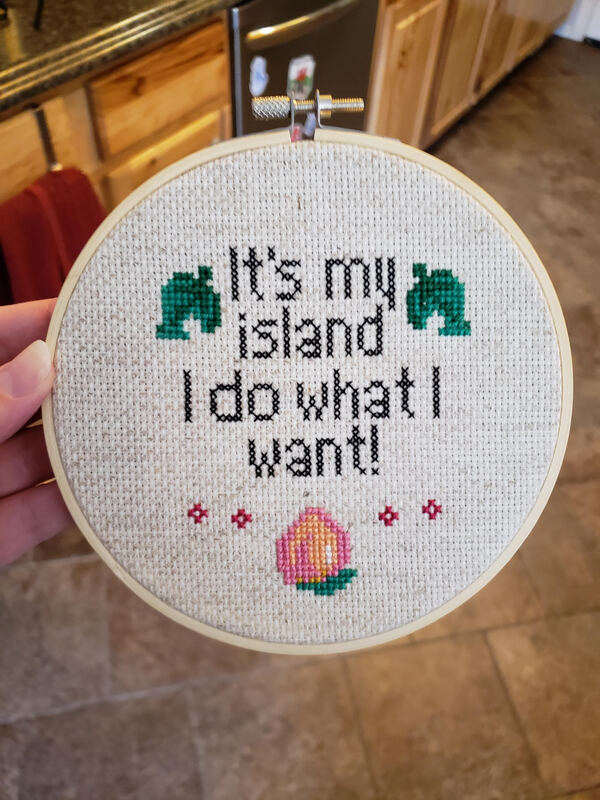
2020-03
I've always used my hands to shape the world around me. Working with my hands both soothes and stimulates, and it feels good to be productive. I've long been known at work for crocheting or cross stitching (my hands can work at those with little help from my eyes) during boring meetings, as a way to keep myself awake and render fruitful an otherwise pointless meeting.
I have some very talented hands, if I do say so myself. I make jewelry, I quilt, I cosplay (itself honestly probably 10 or so different skillsets), I etch glass, embroider, play deftly with resin, string art, and perler beads. You name it, these very talented hands of mine can probably do it. If they can't, someone on Youtube will show me and I will figure it out. My hands are always busy. At least they used to be. COVID took that from me.
When quarantine hit, that is what was left to me. So that is what I did. Fortunately, crafters are notorious hoarders, so that was one thing I struggled little to find when the shelves at all the stores were bare. Whatever it was, it was already in my craft room. When you couldn't find masks anywhere, me and my loved ones never had to worry. I sewed probably 100 from the leftovers I had from a few of my quilts, fun masks with swirling DNA strands, dinosaurs, and Bat-signals. When we couldn't get toilet paper and mom my had to mail me some from out of state, I sent her a giant cross-stitch of her favorite character (Snoopy) as a thank you for being my toilet paper hero. I didn't stop there though. I had to make videos daily for the kids in my (now) virtual classes. So I went from being the women who crocheted in meetings, to the one who painted herself to look like different characters during meetings. (The first student to comment with who I was dresses as that day only had to do half the day's assignment.) The other meeting participants would periodically make me turn my camera on to check on the progress of my transformation. Crafting was really the only thing left to me, what with lockdowns, my school going virtual, the inability to access basic necessities, and the persistent taboo on leaving the house. Crafting got me through it. I made so many things, simply because I needed to be doing something. I sewed, mod podged, and wire wrapped, papier mached, and glass painted, until every wall and surface in my home (and some in my classroom) were covered. Often I'd have the TV on in the background so I'd have noise for company. I'd craft into the wee hours, because it's not like I could go anywhere in the morning. It got so bad that my housemate (a dear friend and fellow transplant with no family in Arizona, we moved in together a week before COVID struck because neither of us wanted to live alone) Kristen had to stage a crafting intervention of the "No really, we are out of space. For the love of God, knock it off or get an Etsy store" variety. (I then switched to baking because I don't know how to be if my hands are still. I was accused instead of trying to make her fat.)
I crafted until I ran out of things to craft. Thanks to COVID, I squished a lifetimes worth of crafting into a year. Now I'm out of projects. If I wanted it, I made it already. If anyone compliments something I made it is given immediately as a gift to them, so I can then go make myself a new one and my talented hands can be busy again for a minute. I've taken to cross-stitching random things my friends say, just to have something tactile to do. My hands remain as sharp as ever, poised for the next project, but the brain that fired them has run out of steam.
And I still don't know how to be if my hands are still.
-
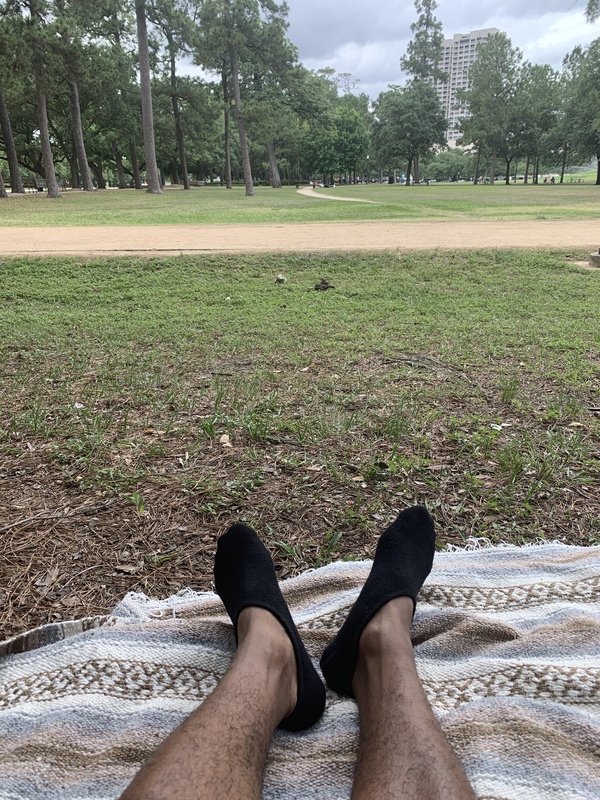
2020-05-12
When I graduated high school, I moved to a different side of Houston, TX. I was quite reserved in my new environment. This was in part because the environment was a bit rough in some parts. However, once the pandemic took place, I decided to explore my surroundings a bit more. I discovered overall, the area was quite nice. In the process of exploring my environment; I decided to check out a park that was five minutes from my house. I had been to this park as a child because of it's proximity to the city's zoo. But, I never went as an adult. The park I discovered, which is known locally as Hermann Park was one of the best discoveries I ever made in my life. This park became my escape. My place of peace. A safe space away from the hustle and bustle of everyday city life. The sensecape was pleasant. The sounds of the birds chirping blissfully while watching a squirrel crawl up a tree brought me to a place of internal calmness I had never experienced before. I enjoyed lying between the trees either in my hammock or laying out on my blanket gazing at the sunset and enjoying the peace and tranquility of the inconspicuous indistinguishable sound of people talking who were coming and going.
-
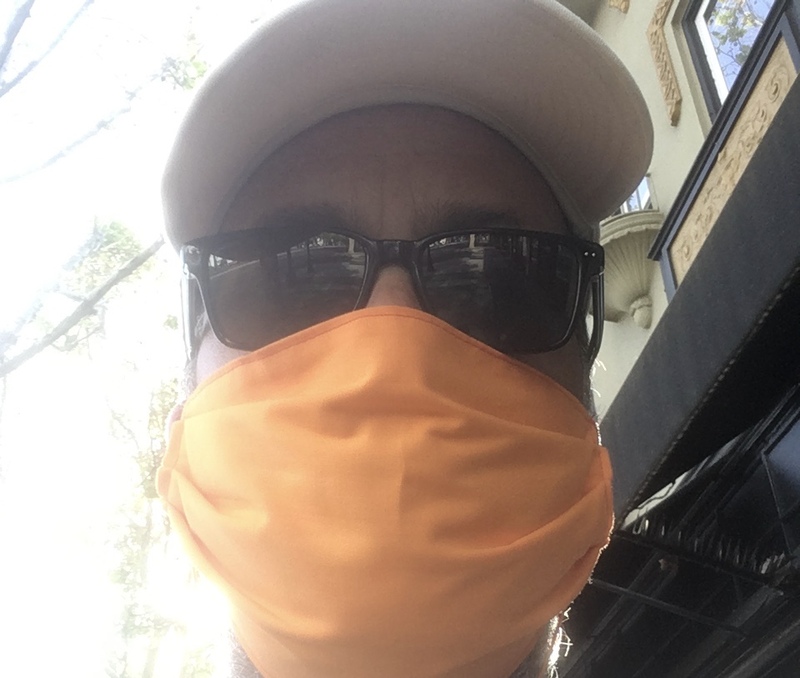
2020-04-25
The ability to hear, the ability to speak, the ability to process what has been said and respond. All of these changed for me in my classroom because of COVID. First the students went totally away, silence, and not the comforting restorative kind, but the absence of those that have become part of me. Suddenly gone silent. After some time they return but not near enough. Talking and hearing through masks obscures and diffuses the words. Can you please repeat that, repeated over and over again. Words cannot get through the first time. Or the second. Frustration sets in and lingers even now. Lack of hearing becomes a lack of understanding and lack of empathy. Habits of caring and concern atrophy. I have endless patience with my students, less so for the rest of my fellow man. The man that refuses to wear a mask across the aisle on a flight home, telling me to shut up when I request that he cover his face. Maybe he can hear, but just refuses to. The relative that isn't vaccinated but still wants to come to the funeral and risk others. They cannot hear my wisdom, though they might tell you that I cannot hear theirs. The masks come off but still the hearing does not return. The classroom starts to normalize, but the rest of the world does not.
-
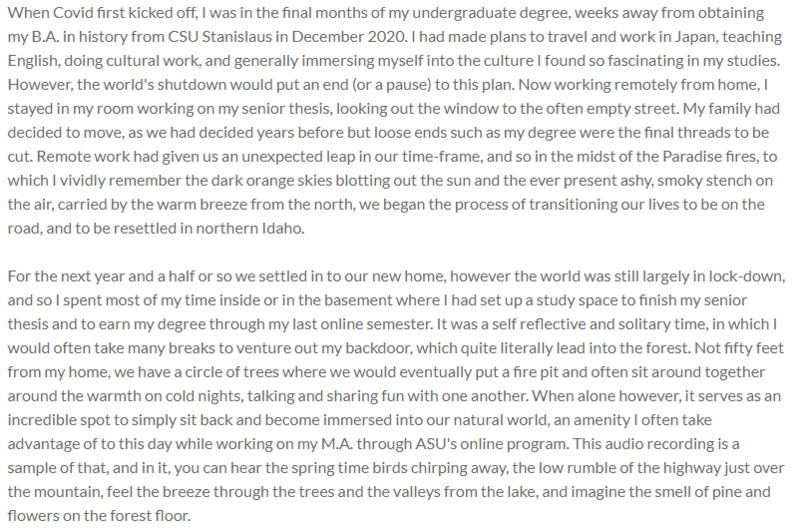
2022-05-26
When Covid first kicked off, I was in the final months of my undergraduate degree, weeks away from obtaining my B.A. in history from CSU Stanislaus in December 2020. I had made plans to travel and work in Japan, teaching English, doing cultural work, and generally immersing myself into the culture I found so fascinating in my studies. However, the world's shutdown would put an end (or a pause) to this plan. Now working remotely from home, I stayed in my room working on my senior thesis, looking out the window to the often empty street. My family had decided to move, as we had decided years before but loose ends such as my degree were the final threads to be cut. Remote work had given us an unexpected leap in our time-frame, and so in the midst of the Paradise fires, to which I vividly remember the dark orange skies blotting out the sun and the ever present ashy, smoky stench on the air, carried by the warm breeze from the north, we began the process of transitioning our lives to be on the road, and to be resettled in northern Idaho.
For the next year and a half or so we settled in to our new home, however the world was still largely in lock-down, and so I spent most of my time inside or in the basement where I had set up a study space to finish my senior thesis and to earn my degree through my last online semester. It was a self reflective and solitary time, in which I would often take many breaks to venture out my backdoor, which quite literally lead into the forest. Not fifty feet from my home, we have a circle of trees where we would eventually put a fire pit and often sit around together around the warmth on cold nights, talking and sharing fun with one another. When alone however, it serves as an incredible spot to simply sit back and become immersed into our natural world, an amenity I often take advantage of to this day while working on my M.A. through ASU's online program. This audio recording is a sample of that, and in it, you can hear the spring time birds chirping away, the low rumble of the highway just over the mountain, feel the breeze through the trees and the valleys from the lake, and imagine the smell of pine and flowers on the forest floor.
-
2022-05
As someone who is very affectionate, the loss of touch throughout this pandemic has been devastating. While hugs, handshakes, fist bumps, and all kinds of other casual touches were second nature before March of 2020, six feet apart became the standard overnight. Greet your friends with an elbow bump, not a hug, and don't get too close because you might get sick. In May 2020, my first nephew was born, and I didn't get to snuggle him for months. It felt like I was missing out on vital connections with him, because I interacted from afar with a mask on.
I live alone, and this loss of touch felt so isolating. You don't realize how important hugs are until you are quarantined alone for weeks and weeks without the touch of another human being.
Now in 2022 as the fear has lessened a considerable amount, the lack of touch still seems to be prevalent in my life. After two years of adjusting to the loss of that particular sense, it feels awkward and forced to show the same affection that used to come easily. It seems like such a silly thing to mourn, the fact that I'm hugging people less. But it's one of those senses that you don't realize the importance of until it's gone. The loss of touch didn't affect everyone, but this completely altered the way I show the people in my life that I care about them.
-
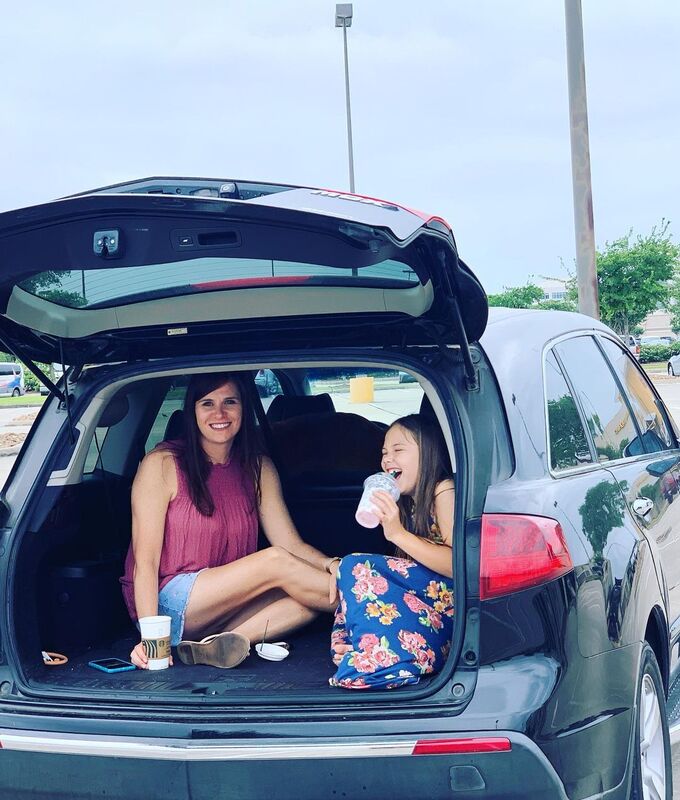
2020-06-01
The pandemic was a time of separation for all of us. The two weeks of isolation to lessen the curve turned into months of remaining at home, at least six feet away from friends and loved ones. As an intensely social creature, this was a time of anxiety and loneliness, despite being quarantined with my husband and three children.
The person I missed seeing most was my best friend, Allison. We spoke on the phone daily, and attempted FaceTime (though it felt awkward to both of us). Prior to Covid, we saw each other at least once a day, working closely together to serve our church and meeting at the playground after school with our children.
In April of 2020, we planned a coffee date with our daughters as a way to see each other and get out of the house. We went through the drive-thru line of a coffeeshop, and drove to adjacent parking lot. We parked opposite of each other, climbed into the backs of our SUVs, and had the first "coffee date" in over a month. Seeing my best friend's face, in person, brought me to tears - as did the distance between us. I needed a hug, desperately. As I drove away that day, I wondered when I would ever get to hug someone outside of my immediate household, when I would shake hands with someone, when I could high five my daughters' friends.
In June of 2020, our church cautiously reopened for in-person services. Masks were enforced, and the six-foot rule was heavily encouraged. However, when I was finally in the same room with my best friend, I couldn't maintain the six foot rule. With my mask on and my hands carefully sanitized, I gave her a hug. It was one of the best hugs of my life.
-
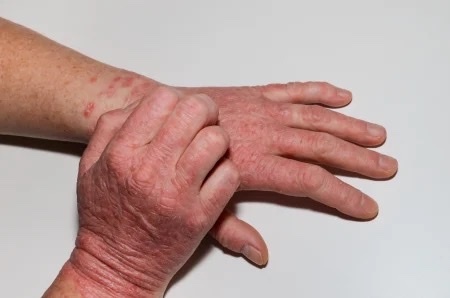
2022-05-25
Listening to Marketplace on the radio each morning as I arrived at work in mid-January of 2020, I never suspected that what was forcing cancelations of Lunar New Year celebrations in China would leave me with raw hands and ringing ears. At that time, I was working at the Census Bureau for the lead person responsible for on-the-ground execution of the 2020 census in Idaho. The work involved data analysis and strategic planning, as we created and staffed a field operation to complement the Census Bureau’s attempt to transition from the traditional door-to-door canvassing to online self-reporting.
In the early days of the pandemic, we tried to maintain business as usual as we, and most of the country, watched cases rise. When things got bad enough, a mandate from Washington shut down our office for nearly six weeks. When our team was called back, we entered a totally new world. The Census Bureau leadership had mandated a hyper safe work environment and work rules. The office furniture was completely rearranged to create social distance. A six-foot perimeter around every desk was marked on the floor to ensure work interactions took place at a distance. Similarly, walking paths were marked on the floor and one-way traffic was encouraged. Everyone was issued a box of masks and hand sanitizers and soap dispensers were everywhere. The visual was pretty laughable but it is my hands and ears that carry the strongest memories of attempting to work in this environment.
Trying to comply with the guidelines meant more hand washing and sanitizing than one would likely see around an operating room. The government, while trying to be a really good parent, however, had failed to supply hand lotion. Shame on me! I didn’t bring my own and raw, chapped hands became my red badge of courage, and compliance. Additionally, I will never forget the volume in that concrete block room. A room full of people on the phone can be noisy; but social distanced work conversations meant masked people shouting to co-workers as they stood six feet from their desk. It was the definition of cacophony. The work I was doing required a lot of attention to detail and I remember it being so loud at times I could not think clearly. There were time I would go outside to listen to quiet of the traffic on the busy street in front of the office.
-

2022-05-23
This biography was created out of a self-directed project from the HST580 class. This biography will be linked to the submissions of the person mentioned in the document and title.
-
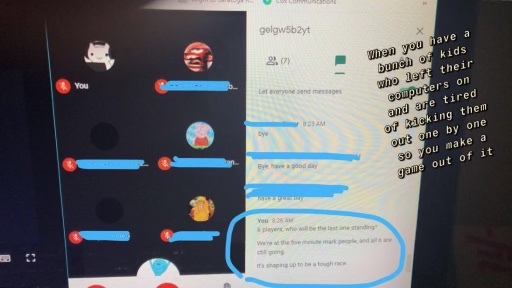
2020-12-08
I taught both middle and high school during the pandemic, which required virtual learning. I lived with a roommate and both of us couldn’t teach at the same time in the same room, so I taught exclusively from the floor of my walk-in closet. I sat on the floor of that 5’x3’ closet every work day for 9 months. The carpet was scratchy and my legs would often fall asleep from sitting in one place too long. I often woke up just before class started at 7:30AM and was groggy. Many of us ate breakfast during first period. The thing that bothered me most however was the silence. The only sound of class was me, talking. My lecture, my out loud readings for accommodated students, and my replies to students typing in the chat were the only things I heard for 5-6 hours of the day. There were none of the usually noises I associate with my job: idle chatter from every corner of the room, tapping of pencils, the pencil sharpener, a student blowing their nose, clicking of pens, hoody zippers, crinkling paper, students moving around in their chairs, chip bags opening, metal water bottles falling on the floor and a student yelling “foul” afterwards, occasional shouting, crying, and groaning. Students very rarely, if ever, turned on their cameras or mics to talk to me. I surely was isolated more than the average remote worker; yes, I talked all day, but it felt like it was talking to no one. I don’t have much tangible evidence to show from the pandemic. Frankly, I didn’t do anything noteworthy of documenting. The three pictures attached are from the beginning of the pandemic, around December 2020. Google Meets hadn’t quite caught up to some of their pitfalls technologically and teachers had to “kick out” each student manually, and when 7-10 of your students are AWOL, it can get tedious. I started to make up dumb games and sing songs to entertain myself, please enjoy my new line to the Oompa Loompa song. You can see that all the students are just icons—no faces, no voices. For reference, I have attached two videos of the end of the school year from before the pandemic. You can hear how loud the classroom is with all the students talking to each other, or playing games and dancing to music. After seeing these small clips, you can understand just how soul-destroying it was to teach to a bunch of digital circles who made no noise.
-

2022-05-23
This biography was created out of a self-directed project from the HST580 class. This biography will be linked to the submissions of the person mentioned in the document and title.
-

2022-05-25
Different taxis and companies usually have different protocols posted. More often than not, there is a plastic or fabric divider between the front and back seats. This sign explains the expectations for passengers traveling via taxi in Arequipa, Peru.
 2022-05-29
2022-05-29 2022-06-04
2022-06-04 2022-06-08
2022-06-08 2022-06-09
2022-06-09 2022-06-06
2022-06-06 2022-06-06
2022-06-06 2022-05-30
2022-05-30 2022-05-26
2022-05-26 2020-09-20
2020-09-20 2020-12-04
2020-12-04 2022-05-10
2022-05-10 2022-05-22
2022-05-22 2022-05-24
2022-05-24 2022-01-13
2022-01-13 2022-02-01
2022-02-01 2020-08-06
2020-08-06 2022-05-24
2022-05-24 2022-05-28
2022-05-28 2022-05-21
2022-05-21 2022-05-22
2022-05-22 2022-05-22
2022-05-22 2022-05-22
2022-05-22 2022-05-28
2022-05-28 2022-04-29
2022-04-29 2022-05-03
2022-05-03 2021-08-10
2021-08-10 2022-05-28
2022-05-28 2022-05-26
2022-05-26 2022-05-26
2022-05-26 2022-05-28
2022-05-28 2022-05-27
2022-05-27 2020-07
2020-07 2022-05-27
2022-05-27 2020-04-10
2020-04-10 2022-05-27
2022-05-27 2020-03
2020-03 2020-05-12
2020-05-12 2020-04-25
2020-04-25 2022-05-26
2022-05-26 2020-06-01
2020-06-01 2022-05-25
2022-05-25 2022-05-23
2022-05-23 2020-12-08
2020-12-08 2022-05-23
2022-05-23 2022-05-25
2022-05-25